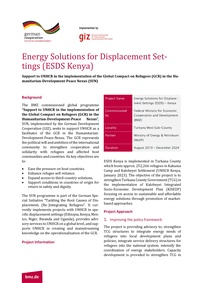Knowledge fuels change
For over a decade, Energypedia has shared free, reliable energy expertise with the world.
We’re now facing a serious funding gap.
Help keep this platform alive — your donation, big or small, truly matters!
Thank you for your support
ESDS Country Portrait Kenya - Factsheet
Background
| Programme Name | Support to UNHCR in facilitating the operationalisation of the Global Compact on Refugees (GCR) in the HumanitarianDevelopment-Peace (HDP) Nexus |
| Project Component | Energy Solutions for Displacement Settings (ESDS) - Kenya |
| Commissioner | German Federal Ministry for Economic Cooperation and Development (BMZ) |
| Locality | Turkana West Sub-County |
| Partner | Ministry of Energy UNHCR Turkana County Government |
| Duration | 07/2019 – 12/2022 |
1. Improving the Policy Framework
The project is providing advisory services to strengthen TCG structures to integrate energy needs of refugees into local development plans; to integrate service delivery structures for refugees into the national system; to intensify the coordination of energy development stakeholders (refugee & host communities, private sector, development partners, NGOs etc.); and to develop a county energy policy. Capacity development shall be provided to TCG officials to strengthen them in assuming their role under the Comprehensive Refugee Response Framework (CRRF) and in steering, implementing and maintaining renewable energy solutions in the County.
Current Activities
- The Turkana County Energy Sector Plan (TCESP) has been finalised and validated; approval and operationalisation by the TCG is pending.
- Development of TCG energy policy has been initiated to be completed by December 2022.
- Human capacity development measures for TCG staff have been conducted on energy efficiency and conservation, energy policy development, communication, and project management.
2. Greening Infrastructure in Displacement Settings
SUN-ESDS seeks to implement best practices for the replacement of diesel generators that power humanitarian operations, in order to allow for cost and energy savings. Advisory services shall be provided to UNHCR on engineering, procurement, construction, operation and maintenance of renewable energy infrastructure as well as viable business models through market-based approaches.
Current Activities
Solarisation of the UNHCR Kakuma sub-office is at the tendering stage with technical assistance from the SUN-ESDS project.
- A technical and financial study is on-going for the solarisation of the Dadaab Sub-Office.
- Environmental and Social Impact Assessment of Kakuma sub-office solarisation measures is ongoing.
- Completion of energy efficiency and feasibility studies for UNHCR-supported institutions and field offices (eight hospitals, six field posts, two RAS offices) in Kakuma.
- Electrification of three health facilities, four schools as isolation facilities, a World Food Programme (WFP) horticultural farm and medical staff accommodation facility as COVID-19 response measures in Kalobeyei Settlement and Kalobeyei Host Town.
3. Increasing Energy Access for Households
Kenya’s access to electricity stands at approximately 75% with off-grid counties like Turkana having access rates as low as 20%; and even less than 5% in refugee camps and settlements. The SUN-ESDS project will promote improved access to clean, reliable and affordable electricity through market-based approaches, benefitting both refugees and host communities. Electricity supply to refugee and host communities will build self-reliance as they will be able to engage in productive uses of electricity e.g. welding, tailoring, barber shops and salons, etc. It will also contribute to security within and outside the camps and settlement.
Current Activities
- Technical assistance has been provided to the private sector for the expansion of the 60kWp solar PV hybrid mini-grid to 541kWp and 1.1 MWh storage.
- An Environmental and Social Impact Assessment (ESIA) for the mini-grid expansion has been completed and a license obtained.
- Construction of Medium Voltage (MV) and Low Voltage (LV) power distribution network is ongoing to potentially connect approximately 2,500 more households, businesses and social institutions in Kalobeyei Settlement and Host Town.
The factsheet can be downloaded here:
Partners
GIZ's Energy Solutions for Displacement Settings (ESDS) project cooperate with UNHCR to enhance the access to sustainable energy in displacement contexts, and the Energypedia page has been created to share learnings across various practitioners to spur the development of clean energy solutions.






















